Guide to Creating a Content Calendar
For access to a free Content Calendar Template, visit our new e-learning portal and sign up for a free account today. You will also gain free access to our Digital Marketing Essentials course, where we break down the fundamentals of digital marketing for you.
What is Content Marketing?
Today, customers expect more from brands; they want an authentic and honest relationship, they want a sense of community, and, more than anything, they want a story.
In this age of the internet, where entertainment and information can be found in seconds, people crave content. Something that attracts and engages them, while providing valuable information or entertainment – this is where content marketing shines.
Content marketing refers to a subsection of digital marketing that involves creating and distributing content, in any format, to various marketing channels. It is an important part of any digital marketing strategy; one that increases brand awareness, builds relationships with consumers, provides information about your product/services, and, most importantly, boosts conversions.
An effective content strategy gives you a connection to your audience because of the added value it provides your customers, going above and beyond the primary value you’re trying to provide through your products and/or services. Taking the time and effort to implement a strong content marketing strategy would position your brand to look more trustworthy and authentic — an edge you’ll need to outshine your competitors.
The downside to an effective content marketing strategy is its many moving parts — there’s a wide range in types of content, various topics, and different channels, but only so many days in a week. This can be overwhelming, which is why being organised and prepared is key to any effective content marketing strategy.
The best way to achieve this? Create a content calendar.
What is a Content Calendar?
A content calendar, also known as an editorial calendar, is essentially a planned schedule of what content is to be published on specific days. Creating a calendar for the first time can be a time-consuming task but, once the routine is established, it will simplify and streamline your content marketing strategy.
One of the main benefits of having a content calendar is that it enables you to keep track and stay ahead of your posting schedule, while also providing an easy overview on your strategy. If you’re working within a team or outsource content creation, it also provides an authoritative source on your content marketing strategy.
Content Calendar Benefits
| 1. | Track and stay ahead of your posting schedule |
| 2. | Provides an overview of your content strategy |
| 3. | Authoritative source of your content marketing strategy |
If you’re familiar with social media marketing, you may recognise the similarities between an editorial calendar and a social media calendar. In truth, an editorial calendar is much more extensive, covering various digital marketing channels and a wide range of content types — from articles and case studies to videos and infographics. Additionally, content calendars can include social media content, providing a wide overview on all content that is posted on a company’s channels.
A content calendar is simple in its makeup; the fundamental elements of a content calendar, which we’ll go into detail later in this guide, are standard, no matter what kind of calendar you create. A typical calendar would include: Days and dates, content types, topics, and channels.
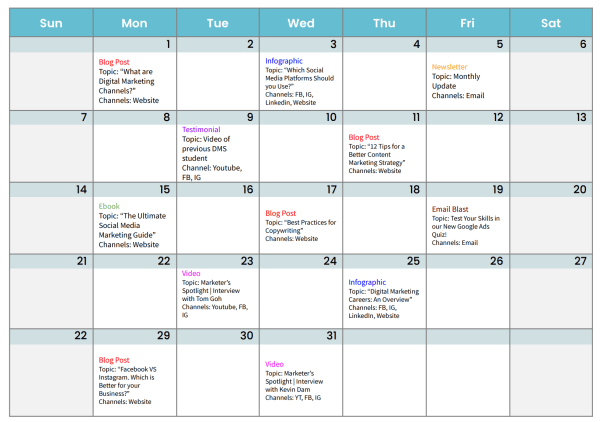
Content Calendar Example
Content calendars are also flexible and can be on a weekly, monthly or even six-monthly basis. It is entirely dependent on what your needs, objectives, and goals are in your content marketing strategy.
Why you Need a Content Calendar
To sum it up, content calendars:
| 1. | Are an organised and concise way to plan ahead |
| 2. | Are comprehensive and detailed |
| 3. | Are flexible, as there isn’t a strict format you have to follow |
| 4. | Simplify and streamline your planning process |
| 5. | Visualise your plan in an easy-to-read manner |
| 6. | Provide an accurate overview of your content marketing strategy |
| 7. | Provide an authoritative source on your content marketing strategy |
| 8. | Enable an easier analysis of how effective your content is and how well it is performing |
As can be seen, having a content calendar can do wonders for your content marketing strategy — it’d almost be amiss to go without one. Let’s take a look at the process you or your content marketing team would have to go through prior to the actual development of your content calendar.
2. Before Creating a Content Calendar
Creating an effective content calendar requires extensive research and planning. Before you get started on creating a content calendar, there are several preparatory steps that you need to take.
2.1 Conduct Research
Research is the cornerstone for any digital marketing strategy. You should always aim to research what may be relevant to boosting your strategy and efforts.
For the creation of a content calendar specifically, we will be going through three types of research: Keyword research, competitor analysis, and audience research. Depending on your experience with digital marketing, these terms may be familiar or completely foreign topics to you. Here’s a brief look into these three research types.
Keyword research is an essential part of Search Engine Optimisation (SEO). However, it can also be greatly beneficial to your content marketing strategy as it could help generate topics of interest that exist within your audience.
Competitor content analysis, allows you to ascertain competing brands and their content — what does and doesn’t work for them.
Audience research, while not as straightforward as the other two research types, can give you an insightful look into what best appeals to your audience.
2.1.1 Keyword Research
First, let’s get into keyword research. Keywords are what individuals use to find your content online. Think about some of the Google searches you might have made this week; how often was it a full sentence? Rarely ever, if at all.
With the advanced search accuracy of Google, users rely heavily on keywords when they make their searches, which you can use to your advantage.
Search Engine Results Pages (SERPs)
The reason keyword research is so crucial is that it affects your position on the Search Engine Results Pages (SERPs). Your position is based on a combination of factors by Google’s algorithms, which affects your visibility to users who are looking for solutions you may provide. If your content is keyword-optimised to be relevant, you can expect higher traffic, leads, and conversions due to the higher visibility on Google.
When you conduct keyword research, use keywords that are relevant to your business to generate other keywords that users are searching for. With this, you can utilise popular or commonly-searched keywords to perfectly design content that directly caters to what your customers are looking for.
As an example, for Equinet Academy, we may use keywords such as:
- “digital marketing”
- “digital marketing strategy”
- “social media marketing”
- “digital advertising”.
If we use this group of chosen keywords, we would receive relevant keywords such as “digital marketing agency”, “digital marketing services”, and “social media marketing agency” which indicates that the users’ possible intent is to search for different digital marketing agencies.
Using this example, we would then brainstorm how to properly incorporate these keywords into content. It might be an article on the “Top 10 Digital Marketing Agencies in Singapore” or an infographic on “Types of Digital Marketing Services”. If it incorporates these keywords well, you could find yourself ranking within the first results page of Google. You can also use a topic research tool such as the one hosted by Semrush here to generate possible topics of interest.
Additionally, when you create content that is highly relevant to what users are searching, you are providing information, solutions, and value — all of which culminate into building brand awareness, a better relationship with your customers, and a reliable reputation.
Keyword Research Tools
With a plethora of keyword research tools at your disposal, it has become easier than ever to research relevant keywords for your brand. We would recommend tools such as Google Keyword Planner, Ubersuggest, Ahrefs Keyword Explorer, and AnswerThe Public, though there are many more out there.
Recommended Keyword Research Tools |
|
| 1. | Google Keyword Planner |
| 2. | Ubersuggest |
| 3. | Ahrefs Keyword Explorer |
| 4. | AnswerThePublic |
2.1.2 Competitor Content Analysis
A competitor content analysis refers to the act and process of analysing the content created by your identified competitors. When you conduct a competitor analysis, you can find out what content types and topics have been the most and least successful for them, and apply this information into your own content marketing strategy.
One of the easiest ways to conduct a competitor content analysis is to review the content on their website. Although not extensive, as it doesn’t cover content they may host on other platforms, it’s a safe bet to believe their website will contain the crux of their content.
There are a few aspects of their content that you should look into: formats, topics, blog post quality, and authority.
Let’s explore these further.
Formats
What content types do they host on their website? Does their content seem to mainly consist of one of two formats or is it varied and diverse? By analysing how frequently they use certain content types, you can gauge what performs well or badly for them, or what is oversaturated or underutilised.
For example, if your competitors rely solely on longform content such as blogs and articles, it might be worth adding visual content types such as videos or infographics into your content calendar. It would help diversify your content array and allow you to stand out from your competitors.
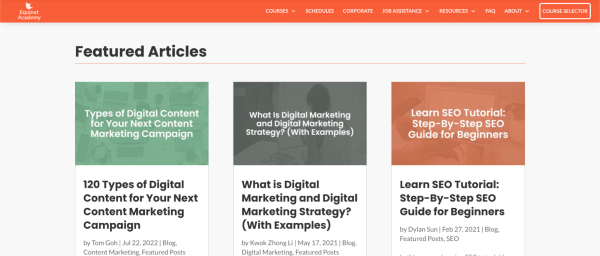
Equinet Academy’s Blog Posts
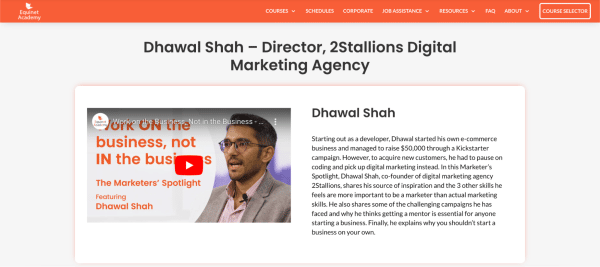
Equinet Academy’s Marketer’s Spotlight Videos
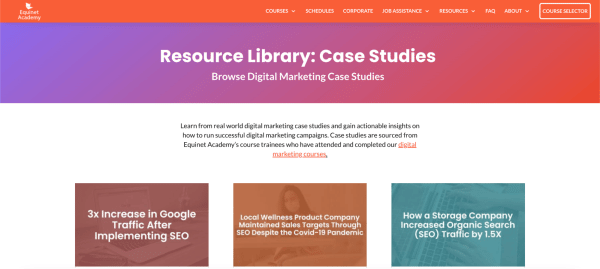
Equinet Academy’s Case Study Library
Topics
When analysing your competitor’s content, do a check for what topics they typically cover and the frequency of these topics. It can provide a look into what might be popular among your target audience or even topics that you should avoid, due to oversaturation.
For instance, if you’re in the skincare industry, you may find your competitors frequently post content regarding skin issues such as “how to get rid of acne” or “how to fix redness”.
This could indicate an abundance of solutions regarding these skin issues and could then point you towards other content topics that are not frequently discussed. Looking at competitors’ content topics can give you valuable insight on what to create.
Blog Post Quality
Most websites host a blog section, due to its ability to boost traffic, build brand awareness, and increase conversions, and is definitely something you should include in your competitor analysis. For blog quality, there are a few factors to take into account.
1. Length
According to The State of Content Marketing 2020, a global marketing report conducted by Semrush, longform content that contains 7,000 or more words receives four times as much traffic as content with an average length of 900 – 1,200 words. By judging your competitor’s blog length, you can start to gauge the quality of their content.
2. Imagery and Design
Do their articles contain visuals such as high-quality images, infographics, or charts? When you include images in articles, they tend to perform better than text-only writings, as those appear wordy and heavy. Analyse what kind of imagery they include in their blog posts, as it may give you an idea of what you should utilise in your own blog.
3. Readability
Go through all their posts and determine how readable they are. Are the articles easy to understand or does it require a certain level of expertise, in both language and subject matter? Additionally, how well-written are their posts? If their articles are filled with grammatical errors or poor wording, it may be safe to assume their posts are lacking in quality.
Authority

Author Bio
Most importantly, you want to look at who is creating their content. Is their content written by, or with, experts and professionals in the industry or is this brand simply working alone in their content creation?
When a business works with industry leaders and professionals on a regular basis, it shows legitimacy and authority. This is something your business should look into starting, if it is relevant to your industry, and is something you should analyse in all your competitors, to give you an effective edge.
2.1.3 Audience Research
Any business will have a key audience that they’re targeting and, with content marketing, you need to know what content appeals to them. Audience research comprises many tools and may not be as straightforward as the previously mentioned research types but, if you can tailor your content perfectly for your audience, you could find your content marketing efforts yielding results.
In this guide, we will be explaining one aspect of audience research to help in creating your content calendar: social listening.
Social listening is the act of tracking mentions of your brand on all social media platforms. Although social listening strictly applies to social media, you can leverage it to produce an effective content strategy and calendar.
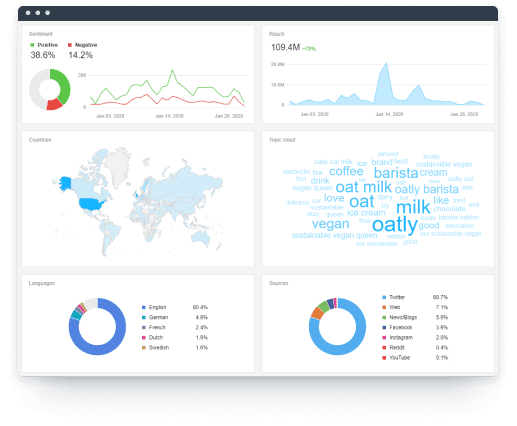
Source: Awario
With social listening, you track your brand, competitors, industry, or specified keywords and when or how they are mentioned by users online. By doing so, you can become aware of your audience’s pain points, track your competitors, identify industry influencers, and generate new sales leads.
With social listening, you become more in touch and aware of what your audience and consumers are saying, or complaining about, and when you become aware of this, you can create content that addresses their wants, needs, and concerns.
There are numerous social listening tools and software available that simplify the process, and are highly recommended, such as Hootsuite, Awario, Sprout Social, Mentionlytics, and Reddit Keyword Monitor.
Recommended Social Listening Tools |
|
| 1. | Hootsuite |
| 2. | Awario |
| 3. | Sprout Social |
| 4. | Mentionlytics |
| 5. | Reddit Keyword Monitor |
2.2 Brainstorm Content Types and Topics
There is an endless list of content types available for you to utilise in your content marketing strategy, which is why choosing the right type may be daunting. This step is for you to learn about and analyse different content types and gauge what might work well for you.
Simple and commonly-used content types would include formats such as:
- Blog posts
- Articles
- Case studies
- Infographics
- Images
- Videos
More difficult to produce and time-consuming content types would include:
- Whitepapers
- Guides
- Templates
As such, it is important to acknowledge your expertise in creating content and to not be overly-ambitious when just starting out.
It is also important to note that each content type serves a different purpose. Longform content, such as blog posts for example, appeals to users who are actively seeking out information or answers to their queries. They want comprehensive solutions and information, which is what you should aim to provide. However, for a content type like infographics or charts, it appeals to those who want information in bite-sized pieces that is much faster to digest at a glance.
Focus on content types that you are familiar with and include them in your content calendar, where you can analyse and make adjustments in the first few iterations, before branching out to other content types. Get yourself into a routine and gauge the success of your calendar before including more content types into your rotation.
If you want to explore different content types, take a look at our list of 120 Types of Digital Content.
2.3 Conduct a Content Audit
If you have already implemented and carried out a content marketing strategy, a content audit will help you revisit and evaluate your content and its success. Essentially, in a content audit, you go through your published content to analyse sections or pieces that are not currently optimised and subsequently, update and refresh it.
In terms of creating a content calendar, conducting a content audit can help you discover areas for improvement, popular topics you can leverage, or content pieces that can be refurbished and reused. While a time-consuming task, a content audit can give your content strategy the revitalisation it needs.
Define your Goals
In a content audit, your goals should align with your overall content marketing strategy. Whether it’s increasing traffic, engagement, or conversions — there should be a synergy in your goals and objectives.
Gather and Categorise your Content
A content audit may cover some or all sections of your content marketing strategy, depending on your goals. Decide which parts you want to analyse, gather their URLs, and categorise them accordingly, based on content type or topic.
Analyse
A simple method of analysing these pages is to use Google Analytics. Input the URLs of your selected pages and go through the data listed which would include metrics such as page visitors, average session duration, and returning visitors.
Take note of pages that perform poorly and compare them to higher performing pages. When analysing these pages, ask yourself these three questions:
- What are the differences between these two pages?
- What is missing from these pages?
- What can be taken and refurbished from these pages to appeal to my audience?
Alongside this, take note of what pages have performed exceptionally well on your website. If it is possible, leverage on the same topics or content types, as you know they are received well by your audience.
Take Action
Once you have identified and analysed poorly performing pages, it’s time to take action. For content that doesn’t achieve its goals, you need to decide whether to delete, update, or re-write said piece. Generally, you should try your best to avoid deleting content and instead focus on updating or refurbishing it, unless you believe there is no longer a need for that specific piece.
Refreshing existing content is a great way to maintain the accuracy and relevance of your content to your audience without letting older content go to waste. For example, if you wrote a blog post two years ago on a topic that has garnered interest recently, updating it to fit the latest thoughts and feelings of your audience can appeal to more without having to write a new article from scratch.
On the same wavelength, you can utilise your higher-performing pages in choosing content types or topics. If you realise that your videos perform the best, be sure to utilise this content type more in your calendar.
3. Steps to Creating a Content Calendar
3.1 Define your Content Goals
The first step in creating a content calendar is defining your content goals and objectives. What do you aim to achieve through your content?
It doesn’t have to be a singular goal and can encompass various aspects, such as higher website traffic, an increase in social media followers, or a boost in brand awareness.
Identify what aligns with your overall marketing goals and objectives, to ensure synergy between your content marketing efforts and your wider digital marketing efforts.
3.2 Determine Content Types
The next step would be to determine your content types using the research you would have conducted, particularly the information you’d have gathered during your competitor analysis and content audit.
Gauge which content types are the most well-received for your target audience and which would be the most flexible or easy to apply to your content topics. For example, if it’s been determined that blog posts are your highest ranking content through audience research, be sure to include that regularly in your plan.
Gather a set of content types that would resonate well with your audience, but be sure to add variety to your content mix as well to prevent content fatigue.
As a tip, colour code these formats in your calendar so that you can easily discern them and their frequency when looking through.
3.3 Determine Post Frequency and Scheduling
How often do you plan on publishing content in general, and with regards to specific content types? This is something you determine based on the content audit you would have conducted; content that is the most well-received should become the cornerstone of your content marketing strategy as it is a tried and tested format.
As for content publication in general, you should create a regular schedule so your audience knows when to expect new content from you. You should also avoid going too long without publishing content, as it can cause a disinterest in your brand.
On the flip side, also avoid posting too regularly, as it can cause overexposure and, subsequently, annoyance and/or content fatigue with your followers.
You should also take into account how much time you, and your team require to create each piece of content, as rushing content could cause a drop in quality. Try a posting schedule of twice a week to start with, and slowly increase your posting if it is feasible.
3.4 Create a Template
Create an editorial calendar template that is simple yet effective. While a content calendar can cover any length of time, it would be good for you to start with a monthly calendar, especially if you’re just starting out.
Otherwise, you can create weekly or bi-monthly calendars too. Essentially, your content calendar template should best fit your strategy, posting frequency, and your manpower for content creation too.
For a free Content Calendar Template, sign up for a free account here. You will also gain access to our free Digital Marketing Essentials course, where we break down the foundations you need to know.
3.5 Stick to your Plan
For your calendar to be effective, you have to stick to your plan and commit to it. While a calendar can be flexible, you should follow it as much as possible so as to avoid disorganisation and an ineffective content marketing strategy.
When you stick to your plan, it provides you with an easy way to gauge whether or not your calendar is working, which would allow you to make changes more effectively. The goal here is to make as many variables as stable as possible in order to accurately identify gaps within your content marketing strategy.
3.6 Optimise your Content Calendar
Once you have created and implemented your content calendar, it’s time to evaluate its effectiveness. Has this new schedule changed anything that puts you closer to your goals and objectives?
Just like a content audit, you have to evaluate how well your content has been performing. Examples of some things you should analyse and optimise if necessary are: If there are particular topics that did or didn’t perform well, if a certain content type outshone the rest, or if a particular day results in lower traffic.
Form a cycle where you evaluate effectiveness after each iteration of your calendar has passed and make adjustments accordingly.
With your content calendar, follow this process each month:
- Plan
- Create
- Publish
- Evaluate
- Optimise
Following this process can help you determine what works best for your business and bring you closer to achieving your content marketing goals.
Key Takeaways
To conclude, content calendars are a necessary tool for any successful content marketing strategy for these following reasons:
| 1. | Are an organised and concise way to plan ahead |
| 2. | Are comprehensive and detailed |
| 3. | Are flexible, as there isn’t a strict format you have to follow |
| 4. | Simplify and streamline your planning process |
| 5. | Visualise your plan in an easy-to-read manner |
| 6. | Provide an accurate overview of your content marketing strategy |
| 7. | Provide an authoritative source on your content marketing strategy |
| 8. | Enable an easier analysis of how effective your content is and how well it is performing |
Start Learning More
If you want to learn more about the extensive world of content marketing, check out our 2-day Content Marketing Strategy Course in Singapore. Everything you need to know to create your own content strategy will be covered in detail, as led by an industry expert.
We also hold a Certified Digital Marketing Strategist (CDMS) Programme which covers the following six modules:
- Digital Marketing Strategy
- Content Marketing Strategy
- Search Engine Optimisation
- Digital Advertising
- Social Media Marketing
- Digital Marketing Analytics with Google Analytics
The completion of these modules will lead the learners to attain a Certified Digital Marketing Strategist Certificate, bringing you one step closer to being a fully-fledged digital marketer. All of these courses are WSQ accredited and available for up to 70% subsidy.
Tom is a native Digital and Content Strategist with 20 years of experience across Tech, Banking, and Digital Advertising and Media verticals. He is also the lead trainer for Equinet Academy’s Content Marketing Strategy and Advanced Content Marketing Strategy course. In his spare time, Tom is actively in the start-up scenes providing pro bono advice to budding entrepreneurs.